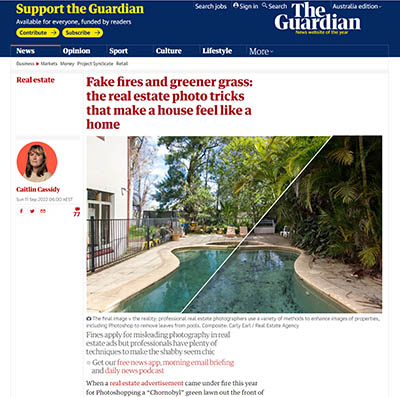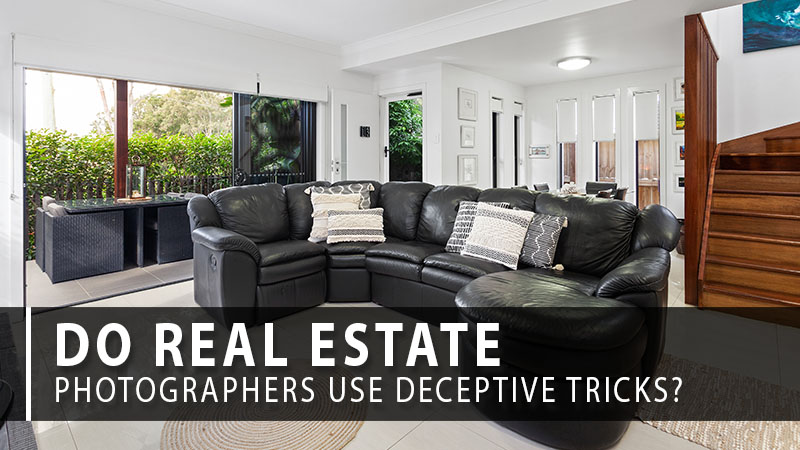There's an interesting article from The Guardian in Australia called 'Fake fires and greener grass: the real estate photo tricks that make a house feel like a home', where a journalist invited a real estate photographer from Sydney to photograph her home, while the journalist took comparison shots.
 Here are some criticisms and observations of real estate photography, from either the article or the comments, together with my own thoughts:
Here are some criticisms and observations of real estate photography, from either the article or the comments, together with my own thoughts:
Article:
"... a ‘mock’ fire burning in a fireplace that no longer functions, is probably misrepresentation whereas, if the fireplace has the capacity to have a fire, then that’s probably OK.”
I totally agree that adding a fire to a fireplace is acceptable, as it would be possible to do this simply by adding some firewood.
However, as noted in this comment from the Real Estate Institute of Australia, adding a fire to a non-functional fireplace would be an example of misrepresentation.
Article:
"She also uses a flash to bounce light to the ceiling, minimising shadows and providing a more balanced shot, and employs “bracketing”, which shoots multiple frames with varying exposures."
What is described here does not change the substance of the home, and is a normal part of photography, since the purpose of using those tools is simply to more accurately show what the human eye would see.
I would also note that the dark photo created by the amateur doesn't represent what the human eye sees in that particular space. Our eyes are very good at adjusting for shadows and for seeing the totality of a scene - cameras are not, at least not in a single exposure. So I don't think showing a room in this way could be regarded as misrepresentation.
So even though an amateur wouldn't be able to recreate that look with a single shot and no editing, that doesn't mean the professional photographer is doing anything inappropriate.
Comment:
"Are you seriously suggesting that photoshopping ‘grass’ into a grassless expanse is somehow ‘professional’."
The real estate photographer spoke about adding grass to a patchy lawn, which I agree is inappropriate, though I have no issue with making slightly brown grass greener, since that's exactly how it would look after a couple of days of rain.
But yes, agents and photographers should avoid adding grass to areas that are devoid of grass.
Comment:
"The ridiculous wide angle lens shots do my head in. Particularly if there is a fridge or tv stretched to impossible dimensions."
When it comes to the use of lenses for real estate photography, there are basically three different options:
10-14mm lenses:
This is what I would categorize as ultra-wide, and these are the ones that show too much in my view. They make small rooms look enormous, and I don't think they help agents because it only leads to disappointed buyers.
16-18mm lenses:
These provide a wide view of a room, but I find that they don't make it excessive. Most photographers and most agents are quite comfortable with lenses of this size.
20-26mm lenses:
These provide a tighter view of a room, but because they show less of the room the potential buyer is provided with less information about the layout of a particular space.
So there are the options for professional photographers, and there are some things for agents and buyers to think about it as well.
For example, the agents who love the use of ultra wide lenses need to factor in the potential disappointment and flak they'll receive from buyers, while buyers who like tighter shots will need to cope with images that provide less information about a home.
That's why I'm most comfortable with the use of 16-18mm lenses which are wide, but not ridiculously wide.
Comment:
"When I'm looking to buy a house (all three times that's happened) I look at the location, the price and the floor plan."
I think the use of floorplans is fantastic, provided they include the dimensions of the rooms (at least the major rooms). They allow for the photographs to show the features and layout of the room, but the buyer is not just relying on the photos to indicate the size of the room. So even if the photographer uses an ultra wide angle lens, the buyer can refer to the floorplan to gain a clear, objective understanding of the size of each room.

